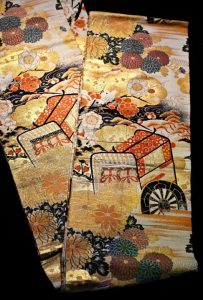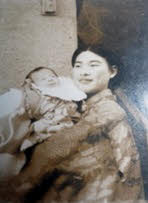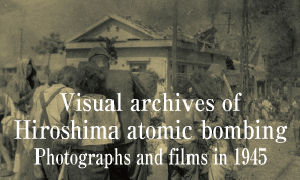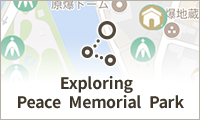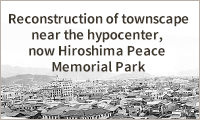Documenting Hiroshima of 1945: September 5, orphaned after mother, older sister die in atomic bombing
Sep. 5, 2024
by Minami Yamashita, Staff Writer, and Kyosuke Mizukawa, Senior Staff Writer
On September 5, 1945, Toshiko Iida, 25 at the time, passed away at the home of relatives in the village of Shinjo (in present-day Kitahiroshima-cho) in northern Hiroshima Prefecture. After the atomic bombing, she had suffered from symptoms caused by exposure to radiation. Her daughter, Makiko, four years old at the time, who was similarly unwell, died on September 4. Toshiko’s husband had been killed in the Battle of Okinawa earlier that year, in June. Their son, Kunihiko, three years old at the time, was the only person in the family of four to survive. Kunihiko is now 82 and a resident of Higashihiroshima City.
Toshiko and her two children were at her parents’ house in the area of Kako-machi (in Hiroshima’s present-day Naka Ward) at the time of the atomic bombing. Located around 900 meters southwest of the hypocenter, the house was destroyed. Although Toshiko and Makiko suffered no noticeable injuries, they later developed a fever, hair loss, and discolored skin. Only later did Kunihiko, who was bedridden with the same symptoms, learn that “they both died after their feet had become necrotic.”
Kunihiko ultimately survived, but he had become an orphan. His grandmother took care of him, but she died before he started school. He was then raised by his aunt and uncle. He tried not to awaken memories that would make him yearn for his mother. But, even now, he will suddenly recall August 6, the day that completely changed his life. “Sometimes I find myself regressing back to my childhood, calling out ‘Mom, help me’,” Kunihiko said.
On September 5, the British newspaper the Daily Express ran a big, front-page headline that read “The Atomic Plague.” The newspaper carried a report by the journalist Wilfred Burchett, who had entered the city of Hiroshima on September 3. He wrote about how people seemingly without injury had been dying. The article also carried comments from local residents who described radiation as the cause and such symptoms as bleeding.
U.S. Army Major General Leslie Groves, who had led the project to develop an atomic bomb, took advance action to downplay the effects of radiation. According to a report in The New York Times on August 31, Mr. Groves said that the Japanese reports of deaths from radioactive effects of the atomic bombings were “pure propaganda” and that the atomic bombs were not inhumane weapons. However, from the situation on the ground in the A-bombed cities, the reality was clear.
(Originally published on September 5, 2024)
On September 5, 1945, Toshiko Iida, 25 at the time, passed away at the home of relatives in the village of Shinjo (in present-day Kitahiroshima-cho) in northern Hiroshima Prefecture. After the atomic bombing, she had suffered from symptoms caused by exposure to radiation. Her daughter, Makiko, four years old at the time, who was similarly unwell, died on September 4. Toshiko’s husband had been killed in the Battle of Okinawa earlier that year, in June. Their son, Kunihiko, three years old at the time, was the only person in the family of four to survive. Kunihiko is now 82 and a resident of Higashihiroshima City.
Toshiko and her two children were at her parents’ house in the area of Kako-machi (in Hiroshima’s present-day Naka Ward) at the time of the atomic bombing. Located around 900 meters southwest of the hypocenter, the house was destroyed. Although Toshiko and Makiko suffered no noticeable injuries, they later developed a fever, hair loss, and discolored skin. Only later did Kunihiko, who was bedridden with the same symptoms, learn that “they both died after their feet had become necrotic.”
Kunihiko ultimately survived, but he had become an orphan. His grandmother took care of him, but she died before he started school. He was then raised by his aunt and uncle. He tried not to awaken memories that would make him yearn for his mother. But, even now, he will suddenly recall August 6, the day that completely changed his life. “Sometimes I find myself regressing back to my childhood, calling out ‘Mom, help me’,” Kunihiko said.
On September 5, the British newspaper the Daily Express ran a big, front-page headline that read “The Atomic Plague.” The newspaper carried a report by the journalist Wilfred Burchett, who had entered the city of Hiroshima on September 3. He wrote about how people seemingly without injury had been dying. The article also carried comments from local residents who described radiation as the cause and such symptoms as bleeding.
U.S. Army Major General Leslie Groves, who had led the project to develop an atomic bomb, took advance action to downplay the effects of radiation. According to a report in The New York Times on August 31, Mr. Groves said that the Japanese reports of deaths from radioactive effects of the atomic bombings were “pure propaganda” and that the atomic bombs were not inhumane weapons. However, from the situation on the ground in the A-bombed cities, the reality was clear.
(Originally published on September 5, 2024)

